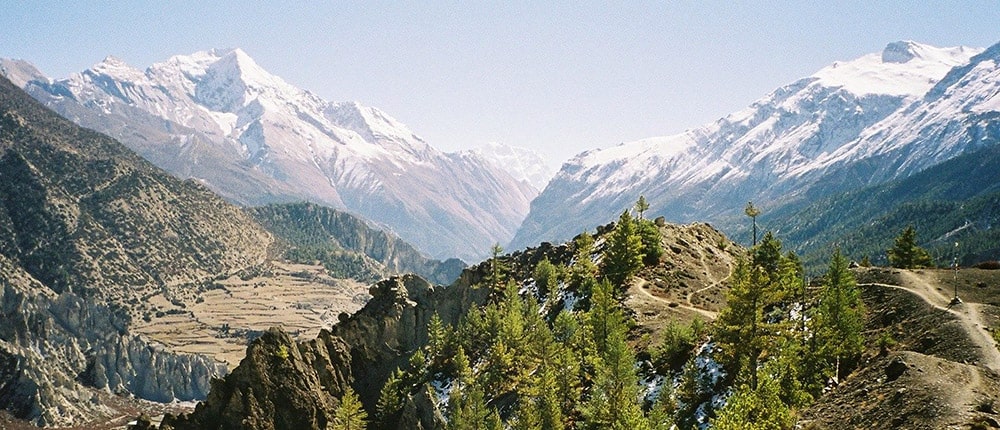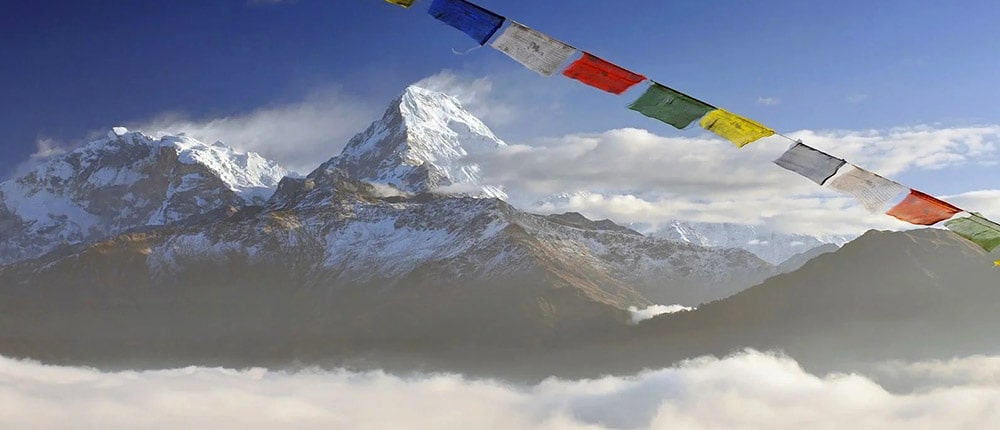1. Overview
The Annapurna Circuit Trek is one of Nepal's most diverse and rewarding long-distance treks. It offers an great experience through traditional villages, and high mountain landscapes. Circling the Annapurna Range, the route passes through subtropical valleys, alpine forests, arid plateaus, and high Himalayan passes, with dramatic changes in scenery and culture along the way.
The trek connects remote communities of Gurung, Thakali, and Manangi people, and crosses Thorong La Pass, one of the highest trekking passes in the world. The Annapurna Circuit is suitable for trekkers seeking a longer itinerary with varied terrain and an evolving cultural landscape.
2. Quick Facts
Duration: 14 to 18 days, depending on route and transportation
Maximum Altitude: 5,416 m (Thorong La Pass)
Trek Difficulty: Moderate to Challenging
Accommodation: Teahouses (basic lodges)
Best Season: March to May and September to November
Starting Point: Besisahar (or further up, depending on road conditions)
Ending Point: Jomsom, Pokhara, or Nayapul

3. Highlights of the Trek
- Crossing Thorong La (5,416 m), a high-altitude pass with panoramic Himalayan views
- Experiencing dramatic changes in landscape, from rice fields to high alpine deserts
- Visiting the sacred site of Muktinath, an important pilgrimage destination
- Walking through traditional villages with diverse ethnic cultures
- Exploring the deep Kali Gandaki Gorge, one of the world's deepest
- Optional detour to Tilicho Lake, one of the highest lakes in Nepal
- Finishing the trek with natural hot springs or a stop in the lakeside city of Pokhara
4. Detailed Itinerary
Below is a standard itinerary for the Annapurna Circuit Trek, including acclimatization days and travel time between key points. It can be shortened or extended depending on preferences and road access.
Day 1: Drive from Kathmandu to Besisahar (760 m), then continue to Dharapani (1,960 m) - 9 to 10 hours total
Day 2: Trek to Chame (2,710 m) - 5 to 6 hours
Day 3: Trek to Pisang (3,300 m) - 5 to 6 hours
Day 4: Trek to Manang (3,540 m) via upper trail - 6 to 7 hours
Day 5: Acclimatization day in Manang - optional hike to Gangapurna Lake or viewpoint (3,900 m)
Day 6: Trek to Yak Kharka (4,050 m) - 4 to 5 hours
Day 7: Trek to Thorong Phedi (4,450 m) - 3 to 4 hours
Day 8: Cross Thorong La Pass (5,416 m), descend to Muktinath (3,800 m) - 7 to 8 hours
Day 9: Trek to Jomsom (2,720 m) via Kagbeni - 5 to 6 hours
Day 10: Flight or drive to Pokhara
Note: An extended itinerary may include Tilicho Lake, Tatopani hot springs, or Ghorepani Poon Hill before ending in Nayapul.
5. Trekking Seasons and Weather
The best time to undertake the Annapurna Circuit Trek is during the spring (March to May) and autumn (September to November) seasons. These months provide stable weather, good visibility, and comfortable daytime temperatures.
- Spring: warmer temperatures at lower altitudes and blooming rhododendrons in forested areas.
- Summer: trails can be muddy and views obscured, especially in the lower section of the circuit.
- Autumn: clear skies, dry trails, and ideal trekking conditions after the monsoon.
- Winter: fewer trekkers and colder temperatures, with snow possible at higher elevations.
Because the route crosses multiple climatic zones, trekkers experience a wide range of weather conditions throughout the trek.

6. Required Permits and Regulations
Trekkers need the following permits for the Annapurna Circuit:
- Annapurna Conservation Area Permit (ACAP).
- TIMS Card (Trekkers' Information Management System).
Both permits can be obtained in Kathmandu or Pokhara through a trekking agency or the Nepal Tourism Board. These documents are checked at entry points along the trail.
7. Physical Preparation and Altitude
The Annapurna Circuit requires a good level of physical fitness due to its length and altitude. Most of the trek is non-technical, but long walking days and gradual elevation gain demand stamina and prior trekking experience.
Acclimatization is essential, especially in the approach to Thorong La Pass. Including at least one rest day in Manang and ascending at a steady pace helps to reduce the risk of altitude sickness. Trekkers should be familiar with symptoms of AMS and follow the guidance of their guide or support team.
8. Accommodation and Meals
Teahouses along the Annapurna Circuit offer simple but comfortable accommodation. Rooms are usually twin-sharing with basic bedding, and shared bathrooms are standard. Some villages provide attached bathrooms and limited Wi-Fi access.
Meals are based on local ingredients and typically include dal bhat, noodles, pasta, soups, and Tibetan-style bread. Breakfast options such as porridge, eggs, and pancakes are widely available. Drinking water can be purchased or purified along the trail. The food is similar to that found in other Himalayan regions, including parts of Ladakh, though the Annapurna region has more varied menus due to its popularity.
